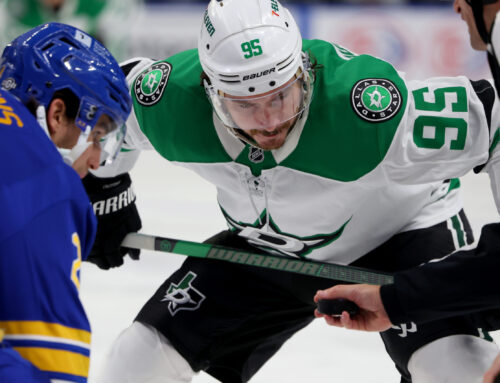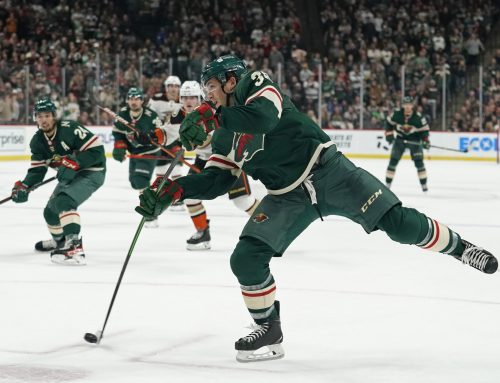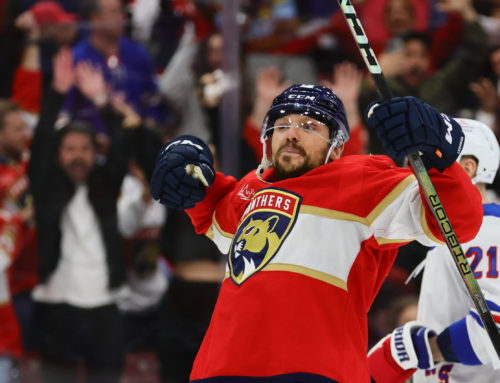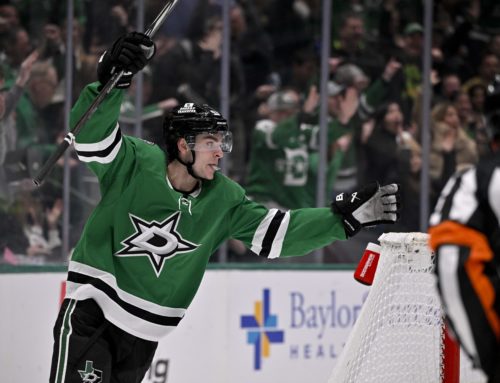
New contracts for Hoffman, Mrazek, and Jarnkrok; thoughts on Toews, and Nash.
****
The Ottawa Senators reached terms with goal-scoring winger Mike Hoffman, signing him on Wednesday to a four-year deal with an average annual value just shy of $5.2-million.
Over the last two seasons, Hoffman leads the Senators with 56 goals, and is third among their forwards with 107 points. While the 56 goals aren’t really a huge total, keep in mind that only 10 of those came with the man advantage, including just one in the 2014-2015 season. To that end, Hoffman’s 39 five-on-five goals over the last two years is tied for 10th among NHL forwards, one fewer than Joe Pavelski, the same total as James Neal and Max Pacioretty, and two more than Jamie Benn. On a per-minute rate at five-on-five (minimum of 2000 minutes played), the only players that have scored more frequently over the last two years than Hoffman are Vladimir Tarasenko, Tyler Seguin, and Patrick Kane.
It is safe to say that Hoffman is one of the league’s top-end scorers. I would hesitate to designate him as such after one season, but after the two years he has had, there is a lot less trepidation. What’s more is that an increased role on the team led to him averaging over three shots a game last year, so while his per-minute shot rate declined, the additional ice time made up the difference. Ice time, and lots of shooting, helps create a goal-scoring floor; over the last two seasons (from Hockey Reference’s Play Index), there have been 50 instances of a forward playing at least 70 games, and averaging at least three shots on goal per game. Of those 50 instances (or players), only four failed to reach 20 goals, 37 of those 50 reached at least 25, and 23 of those 50 reached at least 30. In other words, assuming a constant shot rate and deployment that we saw from Hoffman last year, barring injury, a 25 goal season seems very reasonable.
There is still upside beyond a 25-goal, 55-point season, though (he had 29 and 59 last year). On a per-game basis, Hoffman was sixth among Senators forwards in power play ice time. Hopefully, a new coaching staff will lead to more power play ice time for him. An extra 30 seconds a game could lead to four or five more power play points alone, and push Hoffman close to that 65-point range.
Understandably, there are concerns with Hoffman in roto leagues. The Sens aren’t a very good defensive team, so plus/minus is always a worry. Also, he doesn’t take many penalties, meaning he won’t help there. Without additional power play minutes, he is probably capped at 15 power play points. That means hoping he will be more than a top-100 player in standard roto leagues is misguided. I think he has much more value in a points-only league than a standard roto/points roto league. He could have 30 goals, 30 assists, and 250 shots on goal, and not be a top-100 roto option. Beware of his ADP going into the season, roto league owners; if he’s going inside the top-100, it’s probably best to pass.
****
There was another RFA signed yesterday, though one with less fantasy implications.
The Nashville Predators signed Calle Jarnkrok to a six-year deal with an AAV of $2-million. All things told, I think that’s a pretty good signing for the team, even though I’m not personally a fan of giving term to depth players.
Of course, that last sentence on how Jarnkrok is viewed. He did play over 16 minutes a game last year, just his second full season in the league. The centre Jarnkrok played the most with last year was Ryan Johansen, though 336 out of 1037 minutes isn’t really saying a whole lot. He was the Swiss Army knife forward for the Predators last year, bouncing between all four lines, but mostly in the top-nine.
Jarnkrok did score 16 goals last year, but managed just 14 assists. There was nothing really outlandish about Jarnkrok’s underlying numbers that could influence his assist rate (individual assist percentage, on-ice scoring rate), so it’s not looking like expecting a big increase in assists next year, barring a “lucky” season.
Depending how Jarnkrok is used, I don’t think there is much reason to believe that he’ll be more than a 20-goal, 40-point player. That can play in deeper leagues, but it doesn’t do much for most fantasy owners. He is a player who will probably carry more value in real hockey than in fantasy hockey.
****
One last signing from yesterday was the Red Wings extending goaltender Petr Mrazek for two more years, with an AAV of $4-million. Kind of hilariously, his contract will end before Jimmy Howard’s will.
Despite Mrazek ceding the net at times last year to Howard due to his inconsistency, he still managed to post a .921 save percentage. Since Mrazek came into the league, his .929 five-on-five save percentage is higher than other notable goalies like Ben Bishop, Martin Jones, and Marc-André Fleury. There are other ways to help evaluate goalies – I recommend going through the Twitter timelines of DTMAboutHeart or Nick Mercadente, or visit Corsica Hockey – but for now, he should probably be treated as an above-average goalie.
Of course, we’ve seen what happens when above-average goalies are faced with less-than-ideal circumstances. The names Tuukka Rask and Steve Mason come to mind. When looking at that Detroit defence, there isn’t a lot of hope there. Niklas Kronwall is a shell of his former self, as is Mike Green to a lesser extent, and guys like Danny DeKeyser and Jonathan Ericsson are far from studs. Mrazek could find himself in a similar situation to Henrik Lundqvist last year (and I am not equating him with Lundqvist, mind you): Mrazek could have a very solid season personally, and still not be a top-12 goalie fantasy-wise because of the team in front of him. Frans Nielsen is a solid centre, but he’s no Pavel Datsyuk defensively.
With Howard and his contract still lurking around, and a team seemingly on the decline, I won’t be too invested in Mrazek next year. Goalies are notoriously difficult to project, but avoiding ones in situations like Mrazek is a start. It will all depend on his draft position, but he probably won’t be inside my top-15. For reference, Dobber has him as 17th in his latest top-100 keeper league goalie rankings.
****
There were a couple of veteran players that underwhelmed a bit last year. The first name more than the second, but both are worth a gander as to what went wrong. And here… we… go…
Things may have looked better for Nash’s final production had he played the entire season, but in playing just 60 games, there was little hope of returning investment from his likely second round ADP that he had going last draft season. This is nothing new with Nash, though, as he’s played at least 80 games in just three of his 12 individual 82-game seasons, and has played just 84.3-percent of his team’s games since getting to New York. For a rate, that would work out to be 69 games per 82.
One problem Nash had was that his shot rate cratered; on a per-game basis, he went from over 3.9 shots per game in his first three seasons with the Rangers to 3.05 last year. It’s not much better per minute, as he posted his lowest five-on-five shot rate per 60 minutes last year since 2009-2010. Now, for clarity, his 10.08 shots per 60 was still in the top-20 among regular forwards in 2015-2016, it’s just that he had typically shot so much that it was a significant drop for him, just not in relation to the rest of the league. That’s important to keep in mind.
Just like players have circumstances that surround career-best years, there are also circumstances that surround career-worst years. Consider:
- Nash shot 8.2-percent overall last year, the lowest of his career, and only the second time he shot under 10-percent for a season.
- Nash’s five-on-five shooting percentage was 5.47-percent, his lowest in the Behind The Net era (2007-2008 onward), and the only time it has ever been under 8-percent.
- Nash’s Individual Points Percentage (IPP) – or the rate at which he tallied a point on a goal scored by his team while he was on the ice at five-on-five – was 64.7-percent, again, the worst for him in the BTN era. He had never had a season under 70-percent before, and was 77.8-percent with the Rangers before last year.
Now, this is usually the time when some people may chime in with, “Well he wasn’t crashing the net last year!!!” Well, Behind The Net has an average five-on-five Nash shot distance in 2015-2016 at 29.9 feet, while it was 34.4 feet in 2014-2015 when he scored over 40 goals. Shot distance measurements can be unreliable, but Sporting Charts found similar distance discrepancies (though not the same actual distances) over the two seasons.
Again, the data isn’t overly reliable, but it should at least temper the “CRASH TEH NETT!!!” crowd a little. Hopefully, anyway.
It will be interesting to see where Nash’s ADP ends up this year. I wouldn’t rely on him for more than 70 games, but if you add together his 70 games with a waiver wire player, it seems reasonable that the aggregate gives 30 goals and 55 points. The Rangers may not score a lot this year given their problems on the blue line, but Nash could be a pretty solid value come draft season. Don’t write him off yet.
In a fairly incredible coincidence, Jonathan Toews has scored exactly 28 goals in three straight seasons. The issue lies with the assist total, which has declined in those seasons, from 40 to 30 over that stretch. That was why Toews posted 58 points last year, his second-lowest 82-game season total since his rookie year (the lowest was 57 in 2011-2012 when he played just 59 games).
This is why quality of teammate is very important – Joe Pavelski gets put alongside Joe Thornton in 2011-2012, and after never scoring more than 25 goals, he reels off four straight 30-plus goal 82-game seasons; Chris Kunitz had never scored more than 25 goals in his career until the age of 32, when slotted alongside a certain “Kid.” These examples go on and on. So when Marian Hossa manages his lowest goal total (13) of his career, and his next most-common winger is Andrew Shaw, it’s little wonder why Toews only posted 30 assists.
The conundrum, then, is what will Hossa do next year? The success of Toews in fantasy is inextricably linked with that of Hossa. Assuming the second line (in name only?) of Panarin-Anisimov-Kane is the norm again next year, what is left for Toews isn’t pretty. Richard Panik? Jordan Tootoo? Yikes.
So now the question isn’t just, “How will Toews do next year points-wise?” Rather, the question is, “Can Hossa rebound in the goals department, and in turn, boost the assist totals for Toews?” Without that, I’m not sure there’s a lot of hope for Toews in 2016.
Beyond the assist totals, Toews’s ice time has gone down over a full minute over the last few years, and no, it hasn’t been a decline in short-handed ice time (which has gone down about 10 seconds a game). Rather, he lost about 45 seconds per game in power play ice time between 2013-2014 and last year, no doubt largely thanks to the dominance of the Kane line last year. If they’re anywhere near as successful last year as this year as a trio, I don’t see why Toews’s ice time with the man advantage will be much different.
That 45 seconds a game might not seem huge, but in a full season, that could mean a 4-5 point difference, and that hurts both final production, and power play point totals. That is a fantasy double-whammy.
Toews is another guy whose ADP should be closely monitored. His peripheral stats were never his strong suit, meaning his bread-and-butter in standard roto leagues comes down to point production. If Hossa doesn’t see a significant turnaround, and Toews doesn’t see more time on the man advantage, I don’t see why his production next year will be much different from last year. It’s not an indictment on Toews, either, just of his circumstance. And as of right now, the circumstances aren’t great.
*Stats from Hockey Reference and Hockey Analysis. Cap information from capfriendly.com
4 Comments
Leave A Comment
You must be logged in to post a comment.





 SEA
SEA CHI
CHI OTT
OTT EDM
EDM DAL
DAL STL
STL L.A
L.A ANA
ANA FLA
FLA CBJ
CBJ NYI
NYI

Opinion on Toews if say….it was the following line combinations:
Schmaltz/Toews/Hossa
Motte/Toews/Hossa
Motte/Toews/Schmaltz(highly unlikely I know)
Vesey/Toews/Hossa(if they were to land Vesey…again unlikely)
I think they need to find themselves a winger somewhere, anywhere, if Hossa doesn’t show promising early returns. Banking on either Motte or Schmaltz to be a first liner in their rookie year is asking a lot.
On Toews – if you go back you’ll see I’ve been labeling him as an overvalued fantasy asset for ages. And I think he still is. But truth be told he does have some valuable peripherals in some leagues, notably ones with FOW and SHP.
Yeah value can vary a lot between leagues for guys like Toews who take so man F/O. He had a really good stretch from 2009-2014, but for non-real-time stat leagues, he was always capped in his upside because of lack of shots/PIMs.